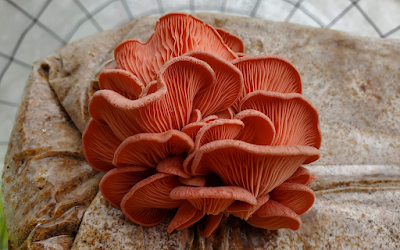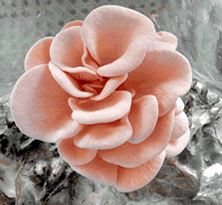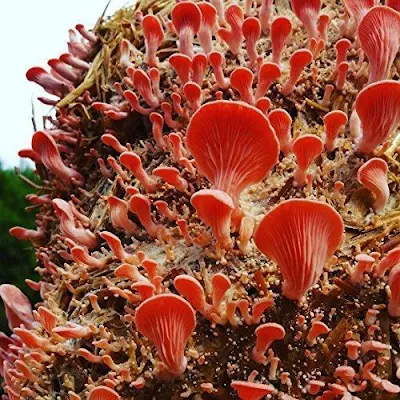Pink Oyster Mushroom Cultivation | Pink Oyster Mushroom Training | Edible Mushroom Cultivation
Pink Oyster Mushroom Cultivation.
- A fresh and glowing flush of bright Pink Oyster mushrooms is a sight to behold.
- Pink oyster mushrooms are vigorous growers, fast colonizers, and heavy yielding. The stunning appearance of these mushrooms makes them a favorite for farmers' market growers.
- Unfortunately, Pink Oysters are delicate and their shelf life is somewhat short, making it tough for them to appear on grocery store shelves.
- Scientific Name: Pleurotus Djamor
 |
| Pink Oyster Mushroom |
GENERAL DESCRIPTION
- Pink Oysters are vibrantly pink, more so when young, as they start to whiten with age.
- The shape of the mushroom is the typical shelf-like shape of the Pleurotus species. The edges of the cap tend to curl with age.
- The mushroom often grows in clusters or large bouquets.
- The underside of the mushroom has the deepest pink color, as the spores are white.
- The mushroom can be quite thick and meaty or delicate and thin, depending on growing conditions.
- Natural Habitat: The pink oyster is a tropical mushroom, preferring warmer temperatures and high humidity. Found on tropical hardwoods.
 |
| Pink Oyster Mushroom |
- Agar: Pink Oyster is unique in that the mycelium is vibrantly pink. Can give the entire agar dish a pink hue.
- Growth can be thin. Plates of Pink Oyster mycelium are sensitive to the cold and will likely die in the fridge.
- Pink oysters are aggressive fruiters and will sometimes fruit on agar, sneaking out the side of the plate to produce small fruit.
- Spawn Types: Rye grain is best. Other grains can be used, including millet. Wild Bird Seed has been used with success.
Pink Oyster Mushroom growing through the plate
Substrate Types:
- Straw is a perfect substrate for Pinks. It will colonize straw very quickly and fruit when ready. Supplemented sawdust blocks can also be used.
- I find the fruits to be larger and thicker when grown on sawdust. Mushrooms tend to store longer when grown on sawdust. Pinks have also been grown on PF cakes.
 |
| Pink Oyster Mushroom |
Fruiting Containers:
- Poly tubing works excellent for straw logs. Grow bags with the top cut-off also work excellent.
- Even garbage bags with slits or large buckets with holes drilled in will serve as suitable containers.
Casing Layer:
- Casing layers serve no benefit to the pink oyster mushroom, so this step can be skipped entirely.
Yield:
- At least 1 lb of fresh mushrooms can be harvested from a 5 lb fruiting block. For straw logs, expect a biological efficiency of 75-150%.
Pink Oysters Growing on Hardwood:
- Harvest: Harvest mushrooms before the spores drop, usually indicated by the cap starting to curl up.
- Pink Oyster mushrooms have a massive spore load and can quickly cover your entire grow room with bright pink spores.
- Cut the mushrooms off in whole clusters, protecting the block or log for future flushes. Simply leave the block or log in to the grow room for subsequent flushes. Watch closely for signs of contamination.
- Pink Oyster mushrooms are best if eaten soon after harvesting, as the shelf life is short.
- Sometimes a pink oyster mushroom will only last a couple of days in the fridge, before eventually taking on the scent of urine.
 |
| Pink Oyster Mushrooms |
- Pink Oysters drop a lot of spores, so make sure to harvest soon. The shelf life is rather short.
- Very susceptible to colder temperatures, so cultures should not be stored in the fridge or will soon die.
Cooking:
- Pink Oysters are delicious and look incredible, but they lose most of their color upon cooking.
- They can be cooked to take on the flavor of bacon, and serve as a good substitute for bacon bits. Can be bitter unless cooked thoroughly.
Spawn Run:
- Keep spawn warm at 23-38 deg C. Grain jars will be colonized quickly, in 7-10 days. Watch for invitro pinning.
Initiate Pinning:
- Pinks will generally just start pinning on their own. Increase humidity, expose to fresh air, and keep a slightly warmer temperature.
Fruit Development:
- Temperatures 20 – 30 deg C. Humidity greater than 85%. Fresh air requirement is higher than king oysters but less than blues.
- Pink Oyster mushrooms are a great choice for home cultivation, especially in the summer or if you live in a warmer climate.
- They colonize substrates extraordinarily quickly, often outpacing contaminants.
- They fruit heavily, and produce stunning bright clusters, making them a farmer's market favorite.
- You won't be disappointed trying to grow pinks at home. Start your journey today!
Where to find it?
You can find this type of mushroom at some grocery stores, health food stores, or Asian grocery stores. You can also find it at farmer’s markets.
Mushroom consultants in India.
Biobritte is an Oyster mushroom supplier company.
You can buy all types of mushroom products from the Biobritte cart.
Top mushroom company.
For more info - https://biobritteagrosolutionspvtltd.in/shop.
Contact on a phone or WhatsApp 9923806933 or 7709709816
Tags- pink oyster mushroom uses, pink oyster mushroom benefits, pink oyster mushroom nutrition, pink oyster mushroom edible, pink oyster mushroom price, pink oyster mushroom taste, pink oyster mushroom smell, pink oyster mushroom psychedelic, pink oyster mushroom recipe, pink oyster mushroom psychedelic, oyster mushroom cultivation using sawdust, pink oyster mushroom growing conditions, oyster mushroom growing problems, pink oyster mushroom growing temperature, oyster mushroom spawn, oyster mushroom substrate recipe, pink oyster mushroom growing temperature, pink oyster mushroom spawn, pink oyster mushroom recipe, pink oyster mushroom growing conditions, pink oyster mushroom benefits, pink oyster mushroom grow kit, pink oyster mushroom vs oyster mushroom, pink oyster mushroom taste
Tags - pink oyster mushroom uses, pink oyster mushroom benefits, pink oyster mushroom nutrition, pink oyster mushroom edible, pink oyster mushroom price, pink oyster mushroom taste, pink oyster mushroom smell, pink oyster mushroom psychedelic

Comments
Post a Comment